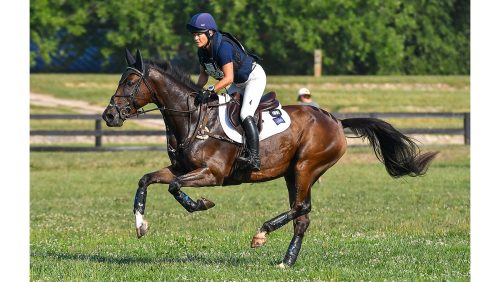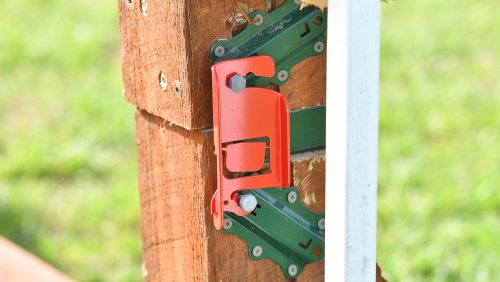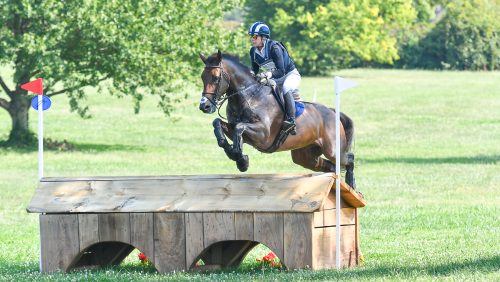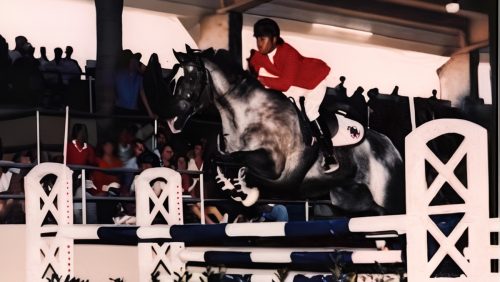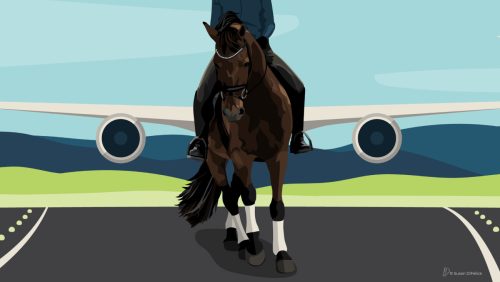Throughout the past year I discovered that how I was approaching learning and achievement had become the main stumbling block keeping me from reaching my goals. Having a fixed mindset and continuous focus on my desired outcome had stifled my ability to cope with what I saw as defeat. Once I started to foster a growth mindset I was able to have a new, more healthy, positive outlook on my journey. I started focusing on learning; I didn’t judge my failures or successes as tests of who I was as a person, and I became more motivated because I knew that I could improve.
Having come to these realizations regarding my own mindset and how it was affecting me, I became acutely aware of the mindset of my students as well. All of a sudden the volume was turned up, and I was hearing, very clearly, the signs of fixed mindset thinking. I realized I have a responsibility to my students and horses to try to foster the same growth outlook within them.
Teaching A Growth Mindset In Our Human Students
Students with a growth mindset aren’t afraid to tackle difficult questions because they see them as an opportunity to gain more knowledge, which is their goal. They have learned to actually enjoy the process because of the feeling of accomplishment they get from learning something new. As teachers we can foster this mindset in our students by:
• Praising effort over outcome
• Teaching students to use setbacks as opportunities for learning
• Having true understanding be the goal of learning (instead of memorizing facts to regurgitate for the test)
• Showing interest in the student’s process
• Showing that learning is a collaborative process by asking things like, “Show me what you’ve done. Let’s try to understand how you’re thinking, and then let’s figure out what you should try next.”
One lesson I had with my dressage coach, Volker Brommann, is a good example of this growth approach.
Volker watched me warm up for a bit, then asked me to take a break and said, “I’m trying to figure out why you’re over-flexing your horse to the left throughout your warm-up.”
He wasn’t judging. He was honestly trying to figure out why I was doing it, so he could address the root cause rather than simply telling me, “Stop doing that.” He said, “Can you tell me what you’re feeling when you’re flexing him?”
I explained that I was constantly flexing the horse to the left because he felt stuck on that side. He responded by saying, “Ah, I see. The problem that I see is that when you fix the stiffness from the inside rein by taking flexion you are making him crooked, and you may not be addressing the cause of the stiffness. So let’s try to address the cause of the stiffness by first straightening your horse and get him consistent in the contact before addressing that issue. I think you may find that the stiffness you feel will go away once your horse is straight and balanced. If not, then we can figure out a way to fix it that won’t compromise the correctness of your aids.”
In this example Volker:
First, tried to figure out why I was doing X in order to solve the problem, in this case taking left flexion. He did this so he could not only help me find a better way of addressing the issue but also help me understand why taking that approach might not consistently get me to the desired answer, so that in the future when faced with a similar challenge I would have more tools to address the issue. He did not tell me, “Taking flexion in that way is wrong.”
Second, he explained why taking flexion in the way that I was could be problematic and then asked me to try a different approach. He also explained why his approach should lead to a better outcome. Meanwhile, he left the door open to the possibility that he may not be correct, but that if he wasn’t correct “we” could experiment to solve the problem together.
Even though he was basically telling me what to do, he made the process collaborative and, by making me feel like part of the process, made me much more engaged in learning.
ADVERTISEMENT
Through this example we can see how Volker was encouraging me to focus on the process and maintain a growth mindset while helping me get to the correct answer. I often leave a lesson with Volker feeling much more confident in myself, and that is true even if he was really challenging me.
It would be much easier for him to say, “You shouldn’t do it that way. You should do it this way.” Or simply, “Do this.” Taking that approach would still get me to do it the way he wanted, but it wouldn’t engage me in the learning process. I would just be doing it because he said so.

Matt Brown (pictured here with Big Berry) believes that when trainers engage their students in the learning process, it builds confidence and gives them the tools to solve their own problems. Lindsay Berreth Photo
There is a time and place, when students are first learning something new, where they have to simply repeat X, Y and Z enough times before they understand enough and can ask the right question or explain why they’re doing something. In that case it’s better for the teacher to simply say, “Right now I want you to repeat these things even if you don’t understand, and once you’ve done this enough times, then we can discuss why.”
As teachers and coaches how we teach can influence our students toward a growth or fixed mindset, which ultimately will have a lasting effect on their ability to continue learning and to reach their goals. Fostering a growth mindset in our students may be the most important aspect of what we teach them. Helping them learn the material is one part of our jobs as teachers, but just as important, or maybe even more important, is cultivating the confidence within themselves to seek out challenges in the learning process. As teachers we can create a judge-and-be-judged framework or a learn-and-help-learn framework.
Setting Process Goals Vs. Outcome Goals
It’s so easy to focus on the outcome. After all, it’s usually the outcome that we’re after, right? But, focusing too much on the outcome can cause a lot of undue stress and anxiety and make us lose sight of what’s important. After all, even if we don’t get the outcome we’re looking for, if we are enjoying and focusing on the process we can still generally gain a lot from the experience. Not to mention that anxiety and horses don’t generally go together very well.
One way I teach my students to focus on the process more and the outcome less is by helping them set process goals before a competition.
Recently a student was preparing for an event, and I asked her what she thought her goal should be for the show. She replied, “Well, I’d like to place in the top three.”
I said, “That would be great, but how much of that goal do you control?”
She said, “I think I’m capable of placing in the top three, but I suppose it depends on who else is in the division. Also it depends on the dressage judge.”
After thinking about it a bit more she added, “I guess it depends on how my horse is feeling that day too.”
I replied, “I agree that you are perfectly capable of finishing in the top three, but I also agree that a lot that goes into that outcome is not within your control. What things that generally help you do well in competition can you focus on that are more within your control?”
She thought for a bit again before saying, “So in general I can focus on staying relaxed and having a good attitude. For dressage I can focus on having clear transitions, thinking ahead and riding with purpose. For cross-country, riding forward, being quiet with my hands and getting on my lines early. And for show jumping, keeping a good rhythm, maintaining the energy in the canter, and staying slow with my upper body.”
ADVERTISEMENT
I smiled and said, “I like that! If you can do those things, I don’t know what place you’ll end up in, but I do know that you could be very happy with your performance.”
A great example of being process oriented and focused was watching Ingrid Klimke at the FEI World Equestrian Games in Tryon, North Carolina, this fall. On one of the warm-up days before dressage Klimke was riding without her stirrups on a large circle doing simple transitions with cavaletti, something that she does to loosen and elasticize her horse as well as her seat.
She chose not to focus on practicing the test movements because she knows that in order for her horse to show itself well it needs to be relaxed, swinging through its body and engaged (not just physically but mentally too), all things that ultimately give her the edge she needs to perform a great test on competition day.
Teaching students to be process focused can help keep them motivated through the ups and downs of success, and, as we all know, there will be many ups and downs. You can give them the tools to experiment with how to find answers and help them understand that getting the wrong answer actually is a good thing because it was an attempt, and as long as they continue to make attempts they will ultimately find the right answer. But more importantly, by focusing on their process they will learn how to ask better questions and ultimately make better attempts in the future.
Here are some reminders of what we can do to help foster a growth mindset within our human students:
• Praising effort over outcome
• Teaching our human students what it means to have a fixed or growth mindset
• Teach students to use setbacks as opportunities for learning
• Have true understanding be the goal of learning
• Showing interest in the students’ process
• Making learning be collaborative
• Focus on learning and teaching, not judging
• Teach students about goal setting and how to set process goals
• And always have patience. It’s a process. Trust it.
In the third and fourth parts to this series I will talk about creating a growth mindset in horses and how mindset and goal setting affects teams.
If you found any of the ideas in this article helpful here are some books that have helped me.
“The Only Way To Win” by Jim Loehr
“True Horsemanship Through Feel” by Leslie Desmond and Bill Dorrance
“Think Harmony With Horses” by Ray Hunt
“Horses Never Lie” by Mark Rashid
“Chop Wood Carry Water” by Joshua Medcalf
“Mindset” by Carol Dweck
“Pound The Stone” by Joshua Medcalf
“Burn Your Goals” by Joshua Medcalf and Jamie Gilbert
“The Obstacle Is The Way” by Ryan Holiday
“The Essential Wooden” by Steve Jamison
“Coach Wooden’s Pyramid Of Success” by Jim Harrick and John Wooden
“Start With Why” by Simon Sinek
Matt Brown has been a lifelong student of the sport of three-day eventing, studying under masters such as Derek di Grazia, Volker Brommann and Denny Emerson. He also credits horseman and rancher George Kahrl for helping him learn how to create a trusting relationship between horse and rider.
Matt has been named to the USEF High Performance Training Lists since 2013. In April of 2015, Matt and his wife Cecily moved from California to Cochranville, Pennsylvania, to continue chasing his dream of representing Team USA. He was named as a reserve for the U.S. team at the 2016 Rio Olympic Games and finished the Rolex Kentucky CCI**** in sixth place in 2017.
You can read all of Matt’s insightful blogs for the Chronicle here.





